
Art market update:
A New Era of Uncertainty
Photo: This fall, Bank of America is proud to be the Lead Opening Partner of the Studio Museum in Harlem
Our previous Art Market Update in fall 2024 predicted the “buyer’s market” that has continued to characterize the current art ecosystem. Driven by stubborn inflation, slower than anticipated interest rate cuts, and the impending U.S. presidential election, last year seemed to demonstrate the maxim that markets favor certainty. Now with the new U.S. administration firmly in place, the art market enters a new era of unpredictability characterized by external shocks, namely natural disasters, geopolitical conflict, and macroeconomic instability. How will tariffs, trade wars, and financial market volatility square with an improving set of art market fundamentals? Will attractive equity prices due to global selloffs raise the opportunity cost of purchasing art, thereby curbing demand? Despite these headwinds, will we see an uptick of major collections and estates at auction and the slow return of the high end of the market? Look for savvy collectors to focus on strategic acquisitions of established artists, transact via private sales, unlock capital with art loans, and even act as third party guarantors as auction houses look to derisk. While some will see this current moment as a deterrent, others will use it as an opportunity.
Experts on the direction of the U.S. modern and contemporary art market
Expert sentiment on the U.S. art market was at a three-year high as of February 2025, with 52% surveyed predicting the market for modern and contemporary art will improve in the year ahead. How will new global trade dynamics affect art market sentiment moving forward?
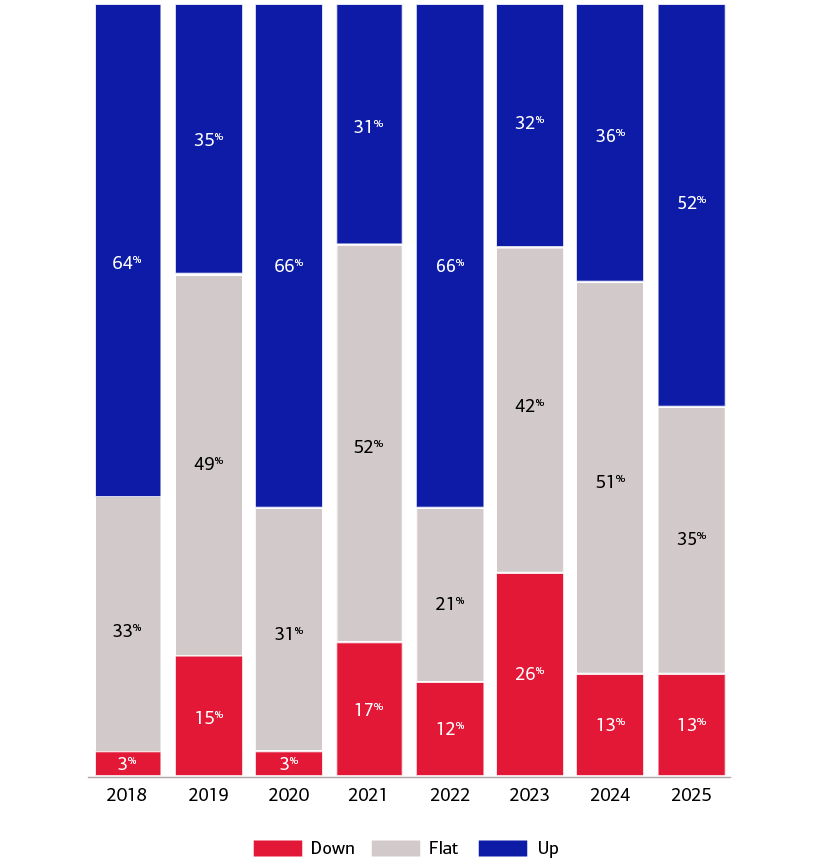
Source: ArtTactic, as of February 13, 2025.
This season’s trends
A recalibration of supply and demand. 2024 saw supply constraints at the top end of the art market. René Magritte’s magnificent L’empire des lumières (1954), which sold at Christie’s for $121 million, was the only nine-figure lot to come to auction in 2024. Compare this to two nine-figure lots in 2023 and six in 2022. So much of what could come to market falls victim to a vicious cycle during downturns: key sellers perceive that conditions aren’t ideal, other discretionary sellers decide to stay on the sidelines, and much of the remaining property for sale is believed to be of lower quality or distressed (albeit with a few notable exceptions). This process dampens collector confidence, diminishes overall sale totals, and further signals a contracting market.
Sales at the high end dampen art market totals
Total sales for works priced between $10 million and $100 million dropped 45.5% in 2024, nearly four times the rate of works priced under $1 million (a 12.5% decrease). Contraction at the high end of the market has an outsized effect on total art market results. (Data from Christie’s, Sotheby’s and Phillips.)
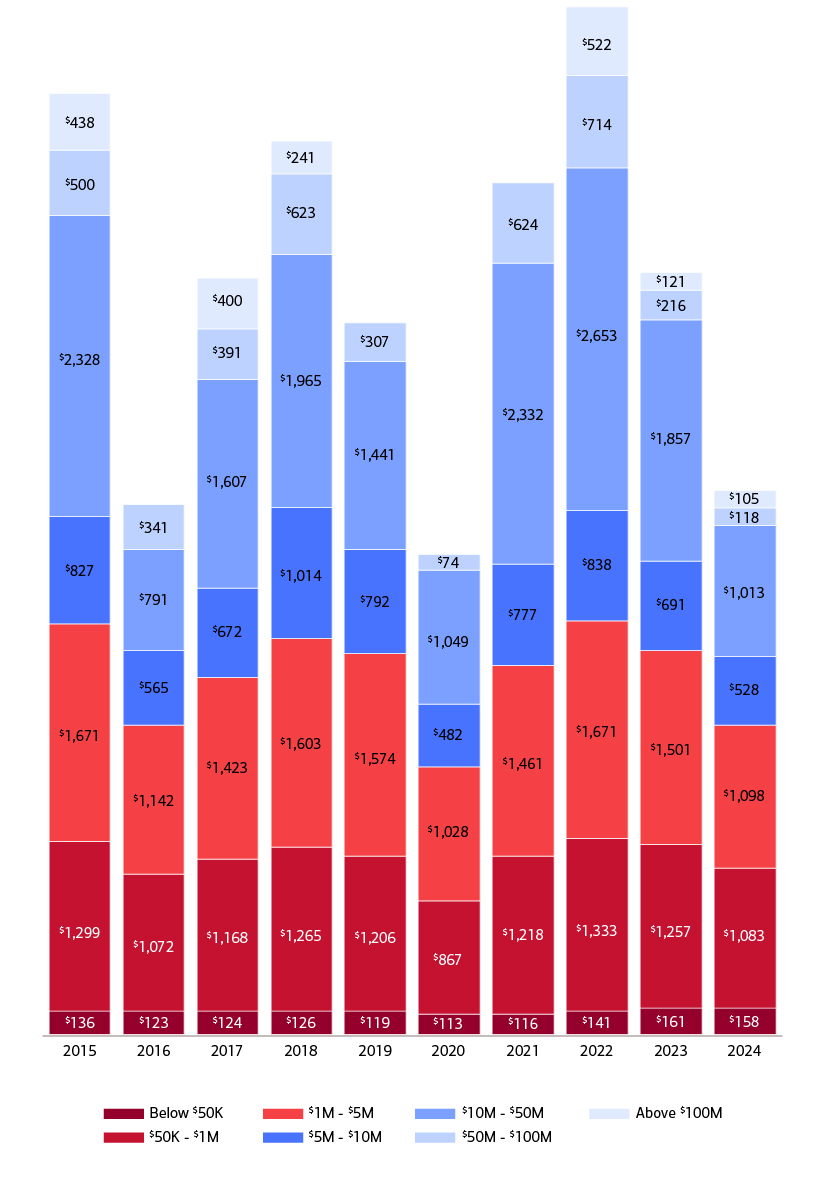
Source: ArtTactic, as of February 13, 2025.
To break this cycle, there must be a clear shift. At the beginning of 2025, we believed that clarity around the new U.S. administration, more favorable macroeconomic conditions, and improving art market fundamentals could do the trick. After all, in 2024, sell-through rates (the percentage of inventory sold versus offered) across auction houses increased from 82% to 84%, the highest rate since 2017, excluding the 2021 bull market.¹ This data indicated that buyers and sellers were increasingly agreeing on equilibrium prices. Moreover, 2024 saw a slight uptick in the price-to-estimate ratio year-over-year: 29% in 2024 versus 27% in 2023.² These metrics indicate stronger depth of bidding and improving collector sentiment.
Supply for the May 2025 sales, including the collection of Leonard and Louise Riggio, was predicated on this data and secured prior to April’s tariff news. While that supply is largely fixed at this point, it is now collector demand that hangs in the balance. Any indication of poor sentiment could limit discretionary selling as auction houses head into fall “business-getting season.”
Sell-through rate ticks up
In 2024, sell-through rates across art, luxury, design and decorative arts saw a three-year high, indicating buyers and sellers are agreeing on equilibrium prices. This may point to healthier conditions ahead. (Data from Christie’s, Sotheby’s and Phillips.)
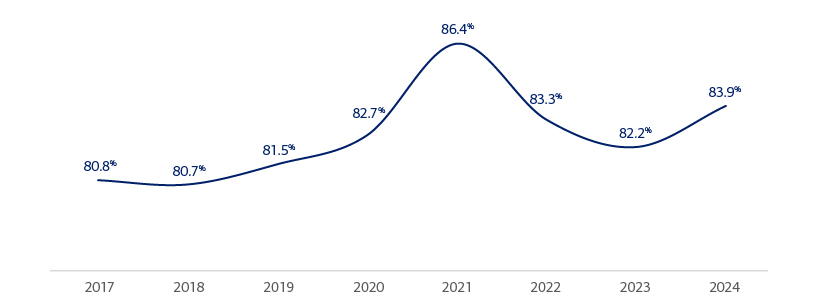
Source: ArtTactic, as of February 13, 2025.
Collectors making safer bets. We expect buyers to continue finding comfort in artists with an established secondary market. In 2021 and 2022, speculative collectors rushed onto the scene flush with liquidity due to historically low interest rates. These buyers spent $347 million on young contemporary artists at Christie’s, Sotheby’s, and Phillips combined in 2022. In 2024, that number fell to $101 million, a 71% decline.³ With emerging artists and speculators alike suffering from this pullback, buyers have become more conservative about the artists whose work they acquire. And given this year’s heightened market volatility, we expect that risk-aversion to continue. But what makes an artist a “safe bet”? Safety implies an artist with a strong reputation, major gallery representation, museum exhibition history, and a proven track record of sales. What does that mean for collectors? We expect to see more of them a) focusing both on historical and market-tested contemporary artists, and b) seeking to buy the absolute best example of an artist’s work that they can afford. Some collectors may then use these works as collateral for an art loan, rather than attempting to sell into a down market, to access liquidity for pursuing timely opportunities.
Strength in private sales. Many collectors buy and sell privately during periods of uncertainty and disruption. For the seller, it provides price control and flexibility. While a private sale can leave upside on the table for a strong work, it also derisks the public downside of selling for a low price or passing at auction. For the buyer, especially at high price points, a private sale provides an exclusive opportunity to acquire something entirely fresh to market. Private sale numbers in 2024 illustrate a preference for this strategy amid contracting auction volume. Last year, Christie’s reported that its private sales were up 41% year-over-year, their highest levels since 2020 — another period of economic stress.⁴ Sotheby’s tells a similar story: Its private sales were up 17% year-over-year in 2024.⁵ We expect to see private sales (along with third party guarantees, which in many ways function as somewhat of a “public” private sale) remain a focus; this strategy will provide a lift to auction house performance as sellers seek to manage their downside risk.
Women collectors on the rise. Perhaps now more than ever, women are using their increasing financial power and influence to both buy and sell art and collectibles that suit new interests and tastes. Both dealers and auction houses have responded, understanding that these new priorities will affect the broader market for the foreseeable future.
As of 2023, women control about one third of wealth in U.S. households⁶ and outlive men,⁷ increasingly making them primary decision-makers when buying art. Women have a rich history as tastemakers (Betty Parsons and Peggy Guggenheim, to name just two of many) and major collectors (Beth Rudin DeWoody, Agnes Gund, and Alice Walton, for example). However, a more recent phenomenon is that women outpace men when spending on art, according to Forbes/Art Basel and UBS.⁸ Now a new cohort including Sarah Arison, Victoria Rogers, Lisa Perry, and Komal Shah have become key art influencers of our time. Much of art spending by women, according to Salon 94 founder Jeanne Greenberg Rohatyn, is due to a sense of patronage rather than financial return.⁹ This quasi-philanthropic mindset can, among other things, drive buying across a broader range of art, including more experimental works by young or previously overlooked artists who have less of a tested market.
As for selling art, women are also incentivized by potential financial gain, tax obligations, and philanthropy. Two key examples of female-driven collections coming to market are those of the late interior designer Mica Ertegun at Christie’s and art patron Emily Fisher Landau at Sotheby’s. Ertegun’s L’empire des lumières by René Magritte in 2024 and Fisher Landau’s Femme à la montre (1932) by Pablo Picasso in 2023 were the most expensive lots of each respective year. These two sales, along with several others over the past few years (such as those of Ginny Williams, Rosa de la Cruz, and Sydell Miller) illustrate the outsized effect of women’s influence on supply at the high end of the market.
New focuses lead auction house strategies. Auction houses are undergoing strategic and financial changes while navigating market shifts. Following two consecutive years of declining sales, Sotheby’s and Christie’s are actively pursuing innovation and diversification to drive competition and tap into new sectors of the market.
Buoyed by a $1 billion investment from Abu Dhabi-based sovereign wealth fund ADQ, Sotheby’s continues to pursue a bold growth strategy. In 2024, the auction house opened a new Paris headquarters and hosted Saudi Arabia’s first ever international art and luxury sale in early 2025.¹⁰ In addition, the house began ramping up its marketing of high-end collectibles, including a historic Stradivarius violin, a copy of the U.S. Declaration of Independence, and exhibition-ready mounted dinosaur skeletons. These interests are already translating into much-needed revenue for the auction house; Sotheby’s attributes 33% of its revenue in 2024 to live and online sales of luxury goods and collectibles.¹¹
Likewise, Christie’s responded to market headwinds with its own expansions. In fall 2024, the company opened a new Hong Kong saleroom and strengthened its luxury arm by acquiring Gooding & Company, a premier classic car auction house. Now it can directly compete with RM Sotheby’s, which has been active in the collectable car market for some time. With Bonnie Brennan’s new leadership and vision at Christie’s, expect a focus on innovation, new technologies and new buyer segments.¹² To that end, in March, Christie’s hosted the first ever major auction house sale dedicated to art produced by artificial intelligence (AI), which largely exceeded expectations.¹³
2024 sales slip across all major art categories
Young contemporary and Old Masters saw the biggest drop-off in 2024 (over 45%), followed by impressionist and modern (29% and 32%, respectively). Post-war and established contemporary, while more resilient, still fell by over 20%. Can auction houses continue to rely on sales of fine art exclusively to drive revenue?
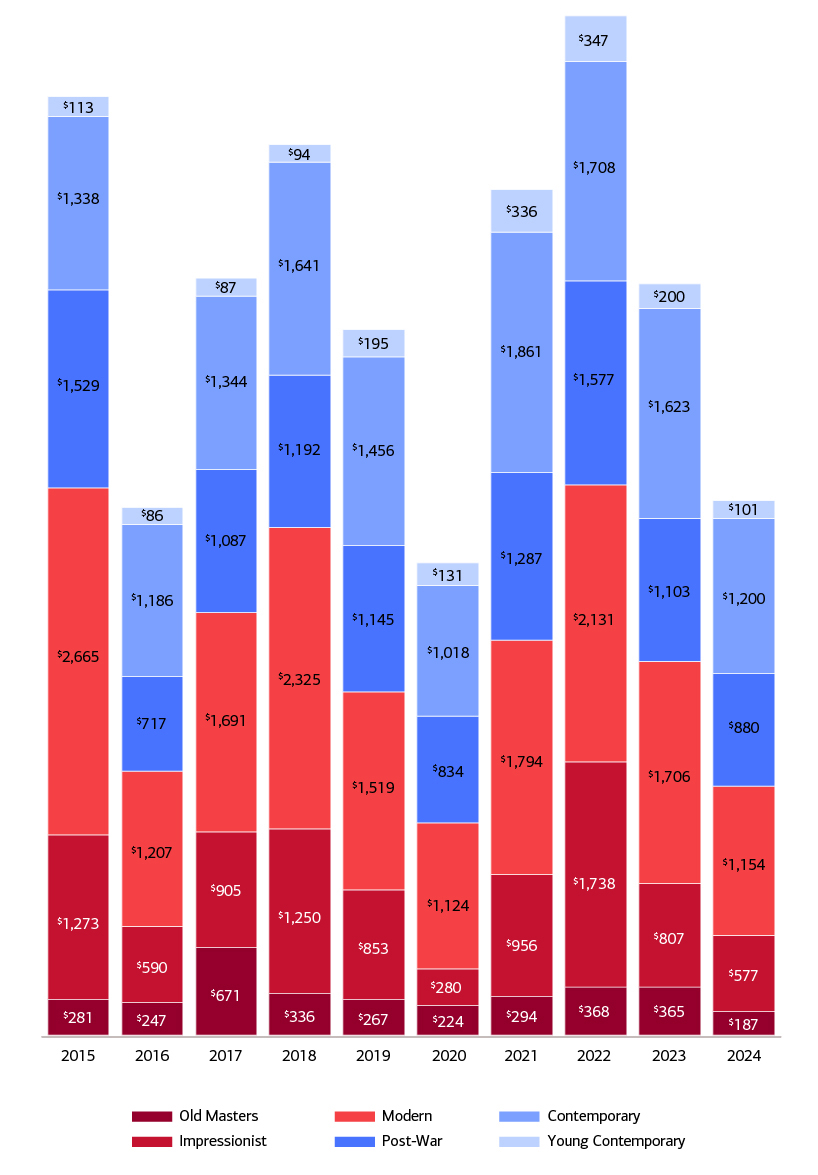
Source: ArtTactic, as of February 13, 2025.
It may seem odd that auction houses are expanding their offerings and geographic footprint amid two consecutive years of declining sales. However, these expansions aren’t happening despite a struggling art market, but because of it. The past two years have exposed the vulnerability of a monolithic art-dependent business, so major auction houses are responding with novelty sales and business acquisitions to diversify their supply and broaden the definition of what an auction house can be. As Sotheby’s CEO Charles Stewart remarked, “We’re venturing into new markets, unveiling spectacular venues around the globe, and welcoming a new generation of collectors to discover another world of art and luxury . . . .”¹⁴
Will any of these new markets or collecting categories match or even overtake the value of the traditional fine art market? Not anytime soon. However, we anticipate these expansions to introduce Sotheby’s and Christie’s brands to new, previously untapped markets. In the short term, this new emphasis will create competition, thereby expanding public price records and increasing liquidity in a broader range of collecting categories. In the long term, it will expose new demographics to fine art, creating a more global and multigenerational art market.
Galleries close, consolidate and implement new models. Headwinds in the contemporary art market have caused a flurry of high-profile gallery closures and consolidation, with some reporting 50% revenue drops from 2023.¹⁵ Several primary market mainstays shuttered in 2024, including Chelsea’s Mitchell-Innes & Nash and Marlborough Gallery, which operated continuously for nearly 80 years. Notably, a possible acquisition of Pace Gallery by Sotheby’s is in discussion. These changes are part of a larger art world trend as the market finds its footing.
Even at a time when sales are down, many galleries find themselves caught in increasingly costly art fair cycles. While some are being more discerning about fair participation altogether, others are getting creative by splitting their booth space, something seen prominently at Art Basel Paris this past fall.¹⁶ Fair-related expenses are unlikely to abate, as art fairs themselves seek external capital to grow and expand into new cities. Art Basel is in talks to receive a $20 million investment for operating Abu Dhabi Art,¹⁷ Miami’s Untitled Art will expand to Houston,¹⁸ and Endeavor Group Holdings is exploring selling Frieze.¹⁹ These shiſts will give more pricing leverage to art fairs, which already account for half of all gallery sales, double the rate of 10 years ago.²⁰
Whereas the sustainability of art fairs remains uncertain, the gallery model itself is also being called into question. Artists are increasingly looking for alternatives to traditional gallery relationships, including joint, agency, or self-representation. The rise of artist agencies is emblematic of an ever-expanding and market-driven art world. 291 Agency, for example, takes a 10% commission on artist income while acting in a fiduciary-like capacity, helping artists navigate relationships with their primary gallery, museums, collectors, projects, speakerships, and more.²¹ These agencies are positioned to fill galleries’ dwindling bandwidth as a result of increased financial pressures.
Meanwhile, some galleries are formalizing co-representation models to split time and resources dedicated to their artists. Hauser & Wirth launched its collective impact model in 2023, where co-representation runs for five years and commissions are split 50/50 between two galleries. Pace and White Cube have followed suit, adapting their own sharing models.²² By co-representing artists, smaller galleries get access to the resources and global network of a large shop while established galleries get access to newer, more diverse talent. Larger galleries can continue to hedge their bets by exhibiting their established artists and counterbalance their roster with rising stars for more opportunistic buyers.
Amid this primary market leveling, collectors will find energized dealers who are motivated to sell, as well as fresh, interesting artists bolstered by major primary market players without the markup.
Q&A with Head of Art Planning for Bank of America Private Bank Rosemary Ringwald
Rosemary Ringwald, managing director and head of Art Planning for Bank of America Private Bank, talks about considerations for art owners in the context of natural disasters.
What are some key issues for art owners to think through related to insurance for their collections?
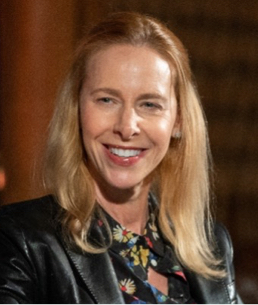
It’s important to understand that insurance for art and collectibles is based on retail replacement value rather than fair market value. Retail replacement value, the cost to replace a property with a similar one at current price, is always higher than fair market value, the price a willing buyer and seller would agree on for a property in an open market. It sounds great to get insurance proceeds that exceed the fair market value of your collection, but in reality, most collections are still underinsured.
Are the proceeds of insurance for damage and loss taxable to the owner of the policy?
Thankfully, no. Insurance proceeds for property damage and losses are intended to reimburse the policy holder, so no tax is due on what you receive. One caveat for art dealers and gallerists: If the insurance proceeds are for business interruption coverage, the proceeds are taxable because they’re meant to replace revenue that your business would have earned if it were operating normally.
What kind of documentation is necessary for art owners to keep considering recent natural disasters?
The importance of keeping an inventory and detailed records about your collection is key for art owners seeking insurance proceeds for damage or loss. Documenting your cost basis in the artwork (purchase price, commissions, shipping and framing, for example), any conservation or restoration work that’s been completed, and the physical location of your artwork is imperative. During the Los Angeles wildfires in January, many people lost the entire contents of their homes. If they’re now relying on their homeowners insurance to cover their loss, they must have photographs of the work and information on cost basis and condition to receive a recovery for their losses under the policy. This highlights the need for a comprehensive inventory that can be kept both on paper and digitally.
For art owners concerned about a pending natural disaster, should they consider moving their artwork to a secure storage facility or to a vacation home?
If there’s enough time to evacuate artwork and collectibles ahead of a natural disaster, choosing a secure and fire safe storage space in the same state is preferable. Moving artwork out of the state where it’s currently located could trigger a “use tax” when it crosses state lines. To explain this, let’s assume I purchased an artwork at a sale in New York and took advantage of the first use rule in California, where I live. That means I can ship the art at the time of sale to a museum in a non-sales and use tax state, like Oregon, and avoid paying any state’s sales and use tax if I exhibit it there for 90 days, even if I move it to my home in California afterward. But if I were to move the art in California to my other home in New York, I would be assessed a “use tax” when it’s hung in my New York apartment at the 8.875% tax rate on the value of the artwork — only because I now “use” it in New York. Additionally, freeports in non-sale and use tax states might be an attractive option for art owners looking to put their art and collectibles in storage ahead of an impending natural disaster. But be cautioned that you must pick a freeport in a state with no sales and use tax to avoid a “use tax” when the artwork and collectibles have been moved. Currently the only states offering no sales and use tax are Oregon, New Hampshire, Montana, Delaware and Alaska.
Are there any tax breaks that might be beneficial to art owners due to natural disasters?
Absolutely! When the governor of a state declares a state of emergency, there are numerous tax benefits to those afflicted with the natural disaster. For example, the IRS and the California Franchise Tax Board have extended the filing date and all tax payments for the 2024 tax year to October 15, 2025, for residents of Los Angeles County as of January 2025. If you purchased artwork, as I did last year, you owe sales and use tax, and if not collected by the seller or dealer/gallerist, your sales tax is due at the time you file your tax return. Now, for all of Los Angeles County, we can hold off on paying our sales tax on art purchases made in 2024 until October 15, 2025. This is a significant benefit for collectors in Los Angeles County who purchased art anywhere in the world in 2024 who didn’t already pay sales and use tax. The delay without penalties and interest in a high-interest-rate environment where you can get nice returns ahead of making a tax payment is a huge benefit.
Curator's Corner

Jennifer S. Brown, curator of Bank of America’s corporate collection, discusses Delita Martin’s Those Things Between Us (2018), which was acquired in 2022, and explains why it’s a compelling — and important — representation of the artist’s experience and vision.
Contemporary American artist Delita Martin crafts intricate mixed-media portraits that blend realism with symbolism, spirituality and cultural memory to create a bridge between past and present. A painter and master printmaker, Martin layers various techniques — including relief printing, lithography, hand-stitching, drawing and painting — to construct richly textured surfaces. She often begins her process with large-scale monoprints, then adds hand-drawn details and patterns inspired by textiles, quilting and African diasporic traditions. This hybrid approach allows her to merge historical craft with contemporary fine art, creating works that feel both timeless and deeply personal.
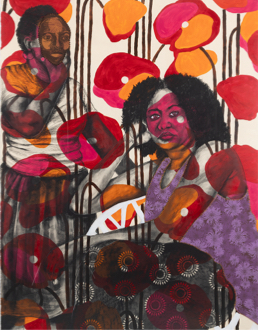
Those Things Between Us, 2018
Delita Martin (American, b. 1972)
Acrylic, charcoal, relief printing, decorative papers, hand-stitching
70½ x 52 inches
Bank of America Collection
Martin’s work exists within a long tradition of figurative art, a genre that’s been central to art history for millennia. From the classical sculptures of ancient Greece and Rome to the portraiture of the Renaissance and the expressive realism of the Harlem Renaissance, artists have used the human figure to explore identity, power, spirituality and social structures. Martin’s work builds upon this legacy while also challenging historical exclusions, particularly the absence of Black women in the dominant narratives of Western art. Through her layered, multidimensional process, Martin constructs a visual language that affirms the complexity and beauty of Black womanhood. Her work invites viewers to contemplate the interconnectedness of past, present and future, while celebrating the enduring strength of those who have come before.
As the founder of Black Box Press Studio in Huffman, Texas, Martin extends her artistic practice to community engagement, mentoring emerging artists and fostering conversations about representation in the arts. Her work has been exhibited in major institutions, including the National Museum of Women in the Arts, the Crystal Bridges Museum of American Art and the Minneapolis Institute of Art.
This unique work will soon be featured in our Art in Our Communities® exhibition The Body Imagined: Figurative Art in the Bank of America Collection.
To learn more about contemporary Black artists and the tradition of figurative art, visit The Time Is Always Now: Artists Reframe the Black Figure at the North Carolina Museum of Art. Sponsored by Bank of America, the exhibition runs from March 8 through June 29, 2025.
Bank of America’s upcoming exhibition sponsorships and cultural institution partnerships
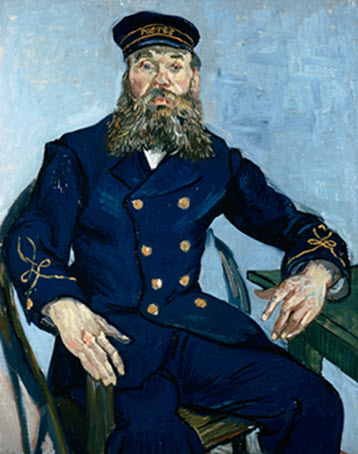
Postman Joseph Roulin
Vincent van Gogh (Dutch [worked in France], 1853–1890)
1888
Oil on canvas
81.3 x 65.4 cm (32 x 25¾ in.)
Giſt of Robert Treat Paine, 2nd
Museum of Fine Arts, Boston
Every year, Bank of America partners with cultural institutions around the world to support their programming. This season’s highlights include a diverse group of artists and art forms.
Marisol: A Retrospective
Dallas Museum of Art
February 23 – July 6, 2025
Organized by the Buffalo AKG Art Museum, this is the most comprehensive survey of Marisol’s work ever assembled, featuring more than 250 artworks and documents.
The Time Is Always Now: Artists Reframe the Black Figure
North Carolina Museum of Art
March 8 – June 29, 2025
Featuring 23 contemporary African diasporic artists from the United Kingdom and the United States, the exhibition focuses on works of art that depict and celebrate the Black figure from the perspective of Black artists.
Van Gogh: The Roulin Family Portraits
Museum of Fine Arts, Boston
March 30 – September 7, 2025
Featuring approximately 20 works by Van Gogh and important loans, the exhibition examines the artist’s relationship with postman Joseph Roulin and his family.
Amy Sherald: American Sublime
Whitney Museum of American Art, New York, New York
April 9 – early August 2025
In her first major museum survey, Amy Sherald presents some 50 paintings from 2007 to the present, from her poetic early portraits to the incisive and moving figure paintings for which she’s best known.
Sir Isaac Julien
Fine Arts Museums of San Francisco – de Young Museum
April 12, 2025 – March 1, 2026
Celebrated for his compelling lyrical films and installations, Isaac Julien has pioneered the concept of the multichannel video installation as a novel form for cinematic storytelling and immersive viewing experience.
Studio Museum in Harlem, New York
Lead Opening Partner
This fall, the Studio Museum in Harlem will open the institution’s first building created expressly for the needs of the institution’s programs and communities.
A Private Wealth Advisor can help you get started.
All opinions are subject to change.
1 RawFacts Auction Review 2024, ArtTactic, 2024, page 7.
2 RawFacts Auction Review 2024, ArtTactic, 2024, page 10.
3 The Art Market 2024: A Year in Review, ArtTactic, December 2024, page 9.
4 Eileen Kinsella, “Christie’s: Auction Sales Fell 16 Percent This Year,” Artnet, December 17, 2024.
5 Kelly Crow, “The Art Market Had a Rough Year. Here’s How It Plans to Turn Things Around,” The Wall Street Journal, January 23, 2025.
6 Shinobu Hindert, “Opinion: ‘Money silence’ has a cost. Let’s debunk these myths about women investors,” MarketWatch, October 21, 2023.
7 Lori Youmshajekian, “Why the Life Expectancy Gap between Men and Women Is Growing,” Scientific American, November 14, 2023.
8 Natasha Gural, “Wealthy Women Spent More On Art This Year Than Men, New Data Shows,” Forbes, November 2, 2023.
9 Sarah P. Hanson, “Women are spending more on art than men — we look at why,” Art Basel, March 7, 2024.
10 Aimee Dawson, “Records set for Arab artists at Sotheby’s debut Saudi Arabia auction,” CNN, February 10, 2025.
11 Scott Reyburn, “As Art Sales Fall, Christie’s and Sotheby’s Pivot to Luxury,” The New York Times, January 9, 2025.
12 Daniel Cassady, “Bonnie Brennan Named CEO of Christie’s, Guillaume Cerutti Remains Board Chair,” ARTnews, January 15, 2025.
13 Leslie Katz, “First Christie’s Auction Devoted Exclusively To AI Art Sparks Backlash,” Forbes, February 9, 2025.
14 George Nelson, “Sotheby’s Records $6B Total Sales in 2024 Amid ‘Clearly Challenging Market Backdrop,’” ARTnews, January 24, 2025.
15 Magnus Resch, “Without A New Approach, Art Fairs Are at Risk of Strangling Galleries,” ARTnews, October 17, 2024.
16 Margaret Carrigan, “Galleries Buddy Up for Booth Space at Art Basel Paris,” Artnet, October 16, 2024.
17 Daniel Cassady, “Sotheby’s Just Got A $1B Lifeline from Abu Dhabi — Art Basel Could Be Next,” ARTnews, November 6, 2024.
18 Maximilíano Durón, “Miami Beach’s Untitled Art Fair Will Expand to Houston,” ARTnews, November 21, 2024.
19 Maximilíano Durón, “Endeavor Explores Selling Frieze, Including Its Magazine, Fairs, and London Exhibition Space,” ARTnews, October 24, 2024.
21 Daniel Cassady, “Meet the Latest Addition to the Art World: The Artist’s Agent,” ARTnews, October 3, 2024.
22 Anny Shaw, “‘Very active participants in their own careers’: why joint representation is proving popular for young artists,” The Art Newspaper, October 8, 2024.




